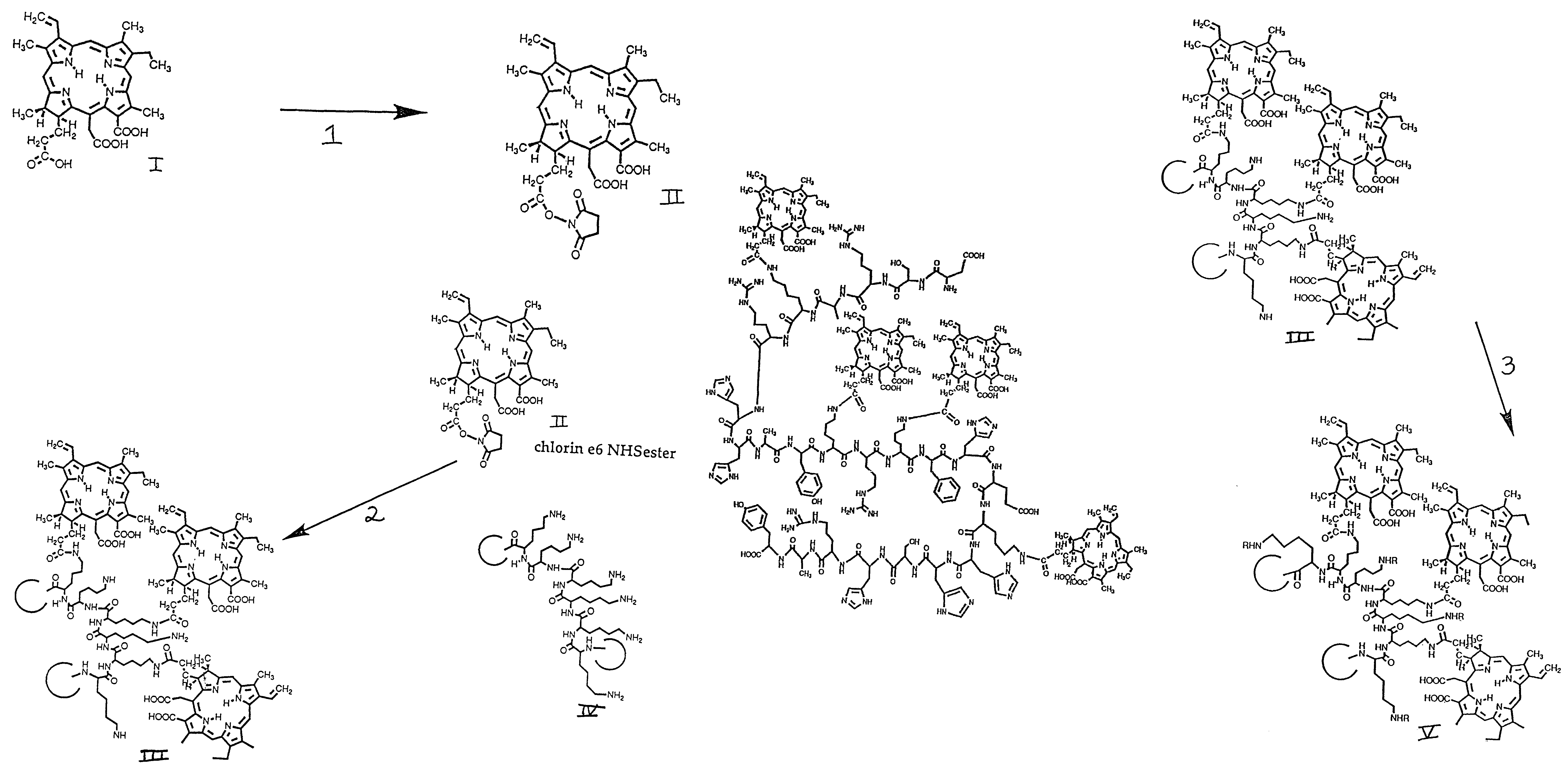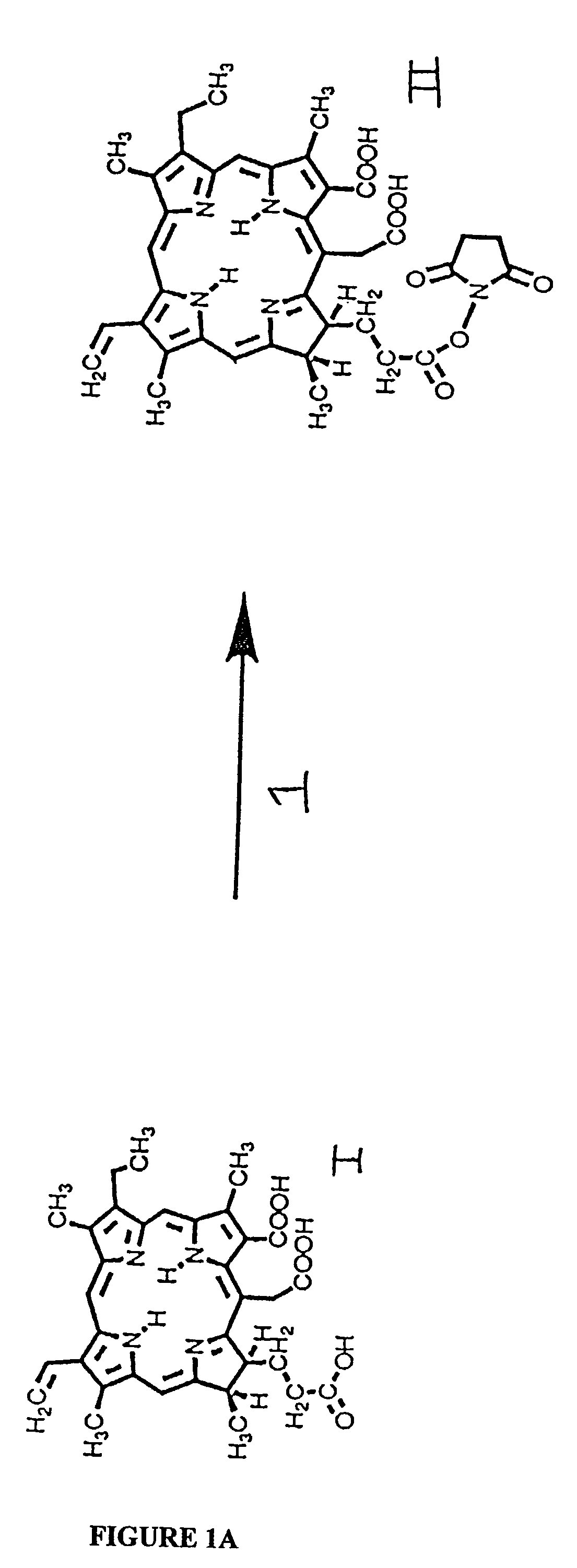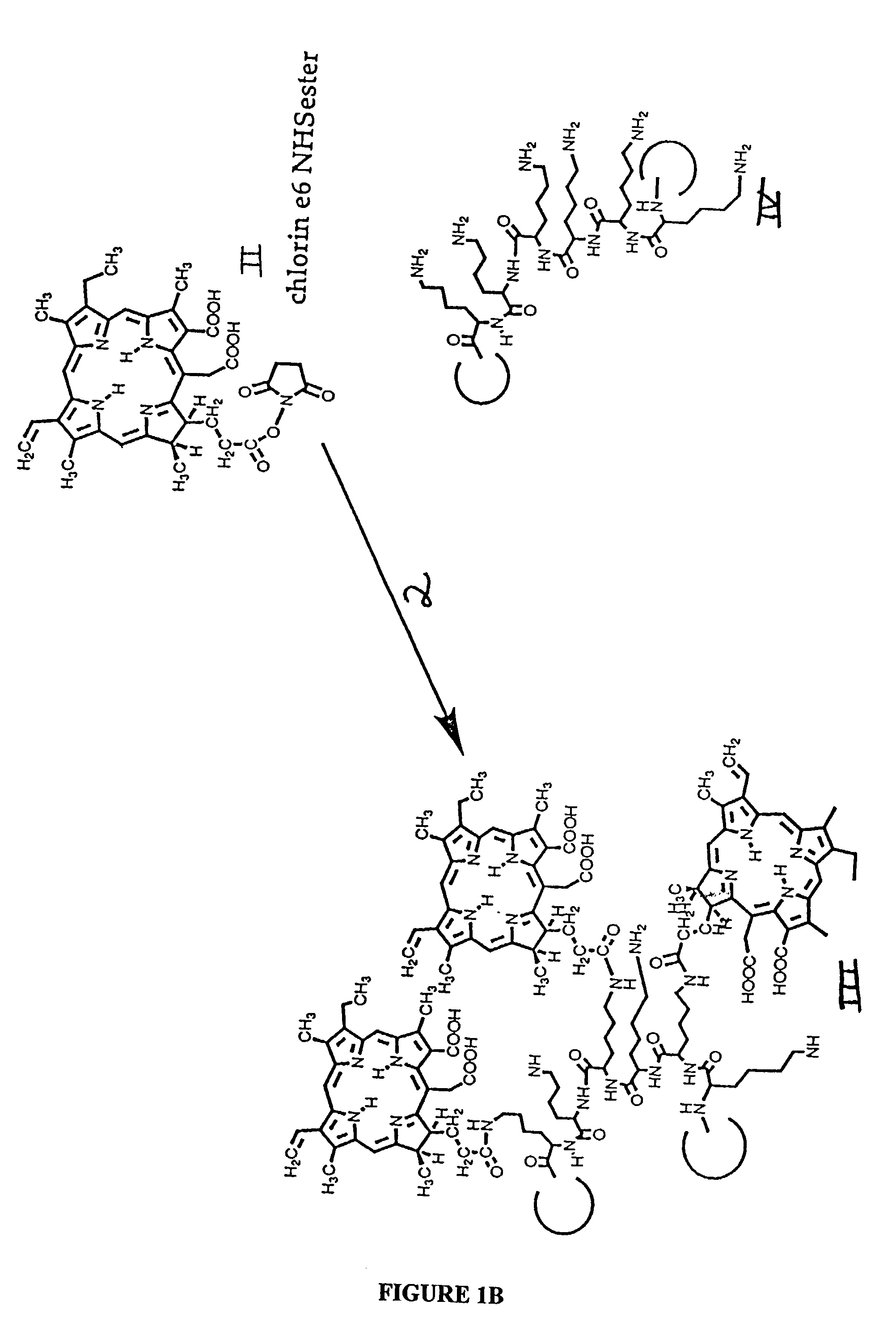Photosensitizer conjugates for pathogen targeting
a technology of conjugates and photosensitizers, applied in the field of conjugates, can solve the problems of unsolved infections and diseases, and achieve the effects of eradicating bacteria, reducing the number of infections, and increasing the specificity of photosensitizers
- Summary
- Abstract
- Description
- Claims
- Application Information
AI Technical Summary
Benefits of technology
Problems solved by technology
Method used
Image
Examples
example 1
Preparation of Polylysine-chlorin e6 Conjugates of Varying Charges
[0255]The N-hydroxy succinimide (NHS) ester of the photosensitizer chlorin e6, was prepared by reacting 1.5 equivalents of dicyclohexylcarbodiimide and 1.5 equivalents of NHS with one equivalent of chlorin e6, molecule I in FIG. 1A, or other photosensitizer in dry dimethylsulfoxide (DMSO) to form the NHS-ester, molecule II in FIG. 1A. The procedure described for the material prepared for use in these Examples, with the photosensitizer chlorin e6, is suitable also for preparation of esters of benzoporphyrin derivative, or any carboxyl containing tetrapyrrole photosensitizer. After incubation in the dark at room temperature for 24 h, the NHS ester was frozen in aliquots for further use. Poly-lysine (molecule III of FIG. 1B) hydrobromide (HBr, 50 mg) of either L or D optical configuration, and of a range of molecular weights (molecular weight 40,000 to 60,000, equivalent to 22,000 to 33,000 polylysine free base) was diss...
example 2
Preparation of Histatin-chlorin e6 Conjugates of Varying Charges
[0260]Histatin-5 (10 mg) was dissolved in 2 ml of 0.1 M Na2CO3 buffer, pH 9.5, and was mixed with 0.1 ml DMSO containing 5 mg of chlorin e6 N-hydroxysuccinic amide, prepared as described in Example 1. The reaction was continued further by incubation for 24 h at room temperature in the dark, and the solution was dialyzed three times against 10 liters of PBS. The resulting green precipitate was dissolved in 2 ml 0.1 M Na2CO3 buffer, pH 10.5.
[0261]Measurements of the absorbance spectrum indicated that, assuming the extinction coefficient at 400 nm of chlorin e6 was unchanged by complexation, i.e., is 1.5×105 M−1 cm−1, and that all chlorin e6 remaining after dialysis was covalently attached to the histatin, it was determined that 4 chlorin e6 molecules were attached per histatin-5 peptide chain. Although histatin-5 is basic, the conjugate was found to be acidic, since lysine amino groups were replaced with two carboxyl grou...
example 3
Preparation of Histatin-polylysine-chlorin e6 Conjugates of Varying Charges
[0263]The DMSO solution of polylysine-chlorin e6 referred to in Example 1 was treated with a solution of N-succinimidyl-3-[2-pyridyldithiopropionate] (SPDP) in DMSO to form polylysine chlorin e6-SPDP, Molecule VI in FIG. 2A. The amount depends on the molecular weight of the polylysine but should be about three to four equivalents per polymer chain. The reaction is incubated for 24 h in the dark at room temperature. The polylysine-photosensitizer-SPDP solution is dialyzed as above.
[0264]The histatin (or other polypeptide containing at least one lysine residue, 5 mg) is dissolved in 2 ml phosphate buffer (SATA, 50 mM, pH 7.5 containing 1 mM EDTA) and treated with N-succinimidyl-S-thioacetate (0.5 mg dissolved in DMSO, 100 μl) for 1 h at room temperature as shown in reaction 6 of FIG. 2B, to form SATA-histatin, molecule IX in FIG. 2B The solution of the peptide is then treated with 200 μl of a solution containin...
PUM
| Property | Measurement | Unit |
|---|---|---|
| molecular weight | aaaaa | aaaaa |
| molecular weight | aaaaa | aaaaa |
| molecular weight | aaaaa | aaaaa |
Abstract
Description
Claims
Application Information
 Login to View More
Login to View More - R&D
- Intellectual Property
- Life Sciences
- Materials
- Tech Scout
- Unparalleled Data Quality
- Higher Quality Content
- 60% Fewer Hallucinations
Browse by: Latest US Patents, China's latest patents, Technical Efficacy Thesaurus, Application Domain, Technology Topic, Popular Technical Reports.
© 2025 PatSnap. All rights reserved.Legal|Privacy policy|Modern Slavery Act Transparency Statement|Sitemap|About US| Contact US: help@patsnap.com



